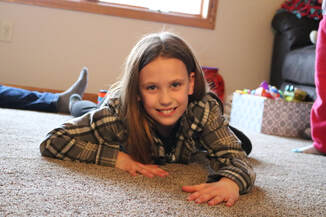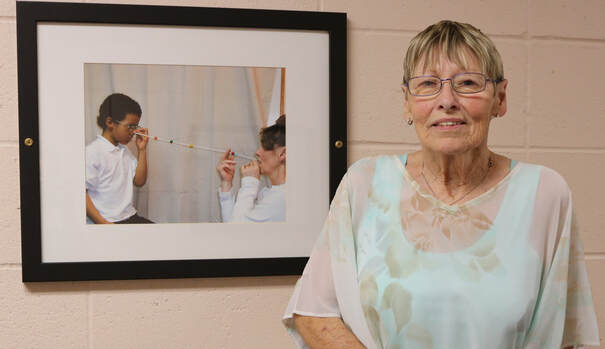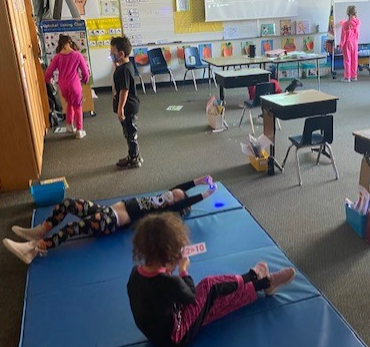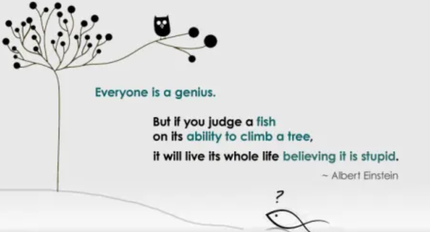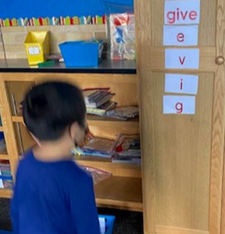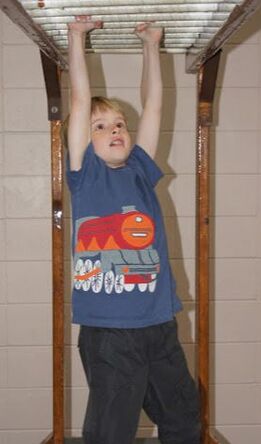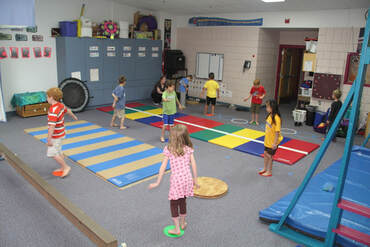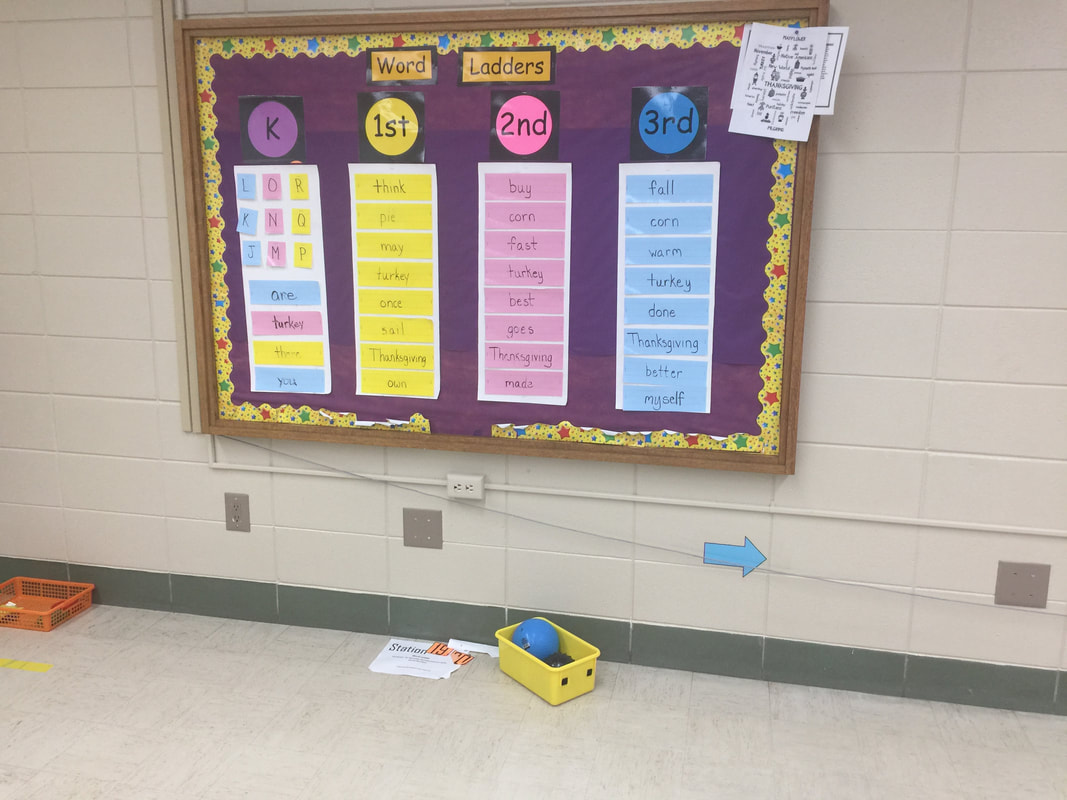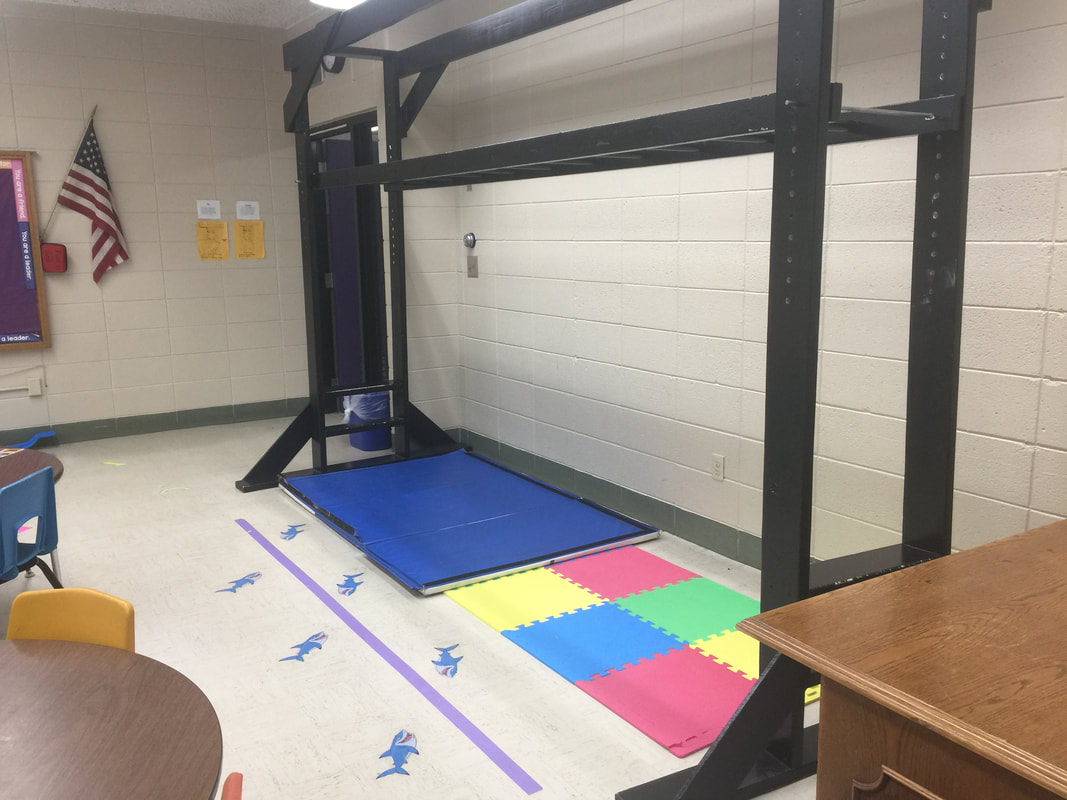|
How do we best prepare our children for future success? For nearly 25 years, our Minnesota Learning Resource Center has addressed this question via S.M.A.R.T. (Stimulating Maturity through Accelerated Readiness Training), a movement-based program designed to enhance brain development in elementary-aged children. With decades of proven results in academic settings, the S.M.A.R.T. team took the next logical step: In 2020, they launched S.M.A.R.T. Steps, a version of the program adapted for Family Child Care Providers working within their homes with newborns to five-year-olds. “This crucial stage in a child’s development sets the foundation for a wide range of skills and learning capacities,” says Katie Hansen, Assistant Director of the program. “S.M.A.R.T. activities strengthen these foundations, like balance and coordination, eye movements, and auditory discrimination. Once these skills become automatic, a child is more equipped to sit still in a chair, read smoothly across a page, and hear differences in sounds - all essential for school readiness and academic success.” With input from the providers, S.M.A.R.T. activities have been specifically tailored to their needs. And the first 18 providers we’ve trained love it! The plan is to take the program statewide in the near future.
Says Darla, a S.M.A.R.T. Steps provider in Sleepy Eye, Minnesota: “A lot of the things I knew in the back of my head, but I just wasn’t putting the two together, like how it was actually helping the child with little things, like sitting or focusing. Knowing that this is really helping my kids in the long run of their lives, and how it can be useful even for me to do, it’s just so positive!” LaDonna, another provider from Sleepy Eye, says her kids love the activities and are now doing them every day. “We like to do stuff all the time - fine motor, gross motor, at least a taste of it every day. And it’s easy for me because I’m not using a big curriculum,” she says. “When we make our projects or read our books, we can get it all put together quickly, no problem.” S.M.A.R.T. Support S.M.A.R.T. Steps is designed to give providers all the training and support they need, at times and in ways that work for them, as well as valuable knowledge that helps them provide high-quality care. The goal was to make S.M.A.R.T. Steps very easy to incorporate into any daycare environment. With lots of little ones running around, it needs to be. Providers don’t always have the capacity to orchestrate activities because they are constantly being pulled in different directions. The key to making it work is an online learning management system, called Thinkific, that gives providers easy access to training and resources necessary to integrate the program into their day. As with other S.M.A.R.T. programs, we provide mentoring services, something other programs don’t always offer. LaDonna says she loves the mentor visits and the hands-on instruction she receives. “They give ideas and help us fine-tune movements - like the pencil roll, for example, to use their hips and to get some speed - I wouldn’t have known those things, but the mentors watch closely to see if we’re doing it correctly.” Currently, these services are offered in person; as the program grows, they will be online to keep the program affordable and accessible. Alissa and her kids like the visits too. “I have some kids that I kind of worry about,” she says, “and Katie can tell me what to do with them. It’s great watching the kids’ eyes light up when they finally get something. We all benefit from it.” Making a Difference According to our providers, their young charges have embraced S.M.A.R.T. Steps activities. “They do the majority of the activities without even being told.” says Darla. “They’ll hop in to wash their hands or do different balance moves like flamingos. Today, we’re working with scissors and cutting with two hands. We’ll do courses with tunnels, balance beams, we do hopping and jumping and helicopters. They like doing fine motor, but their favorite is getting out the large muscle movements.”
Providers said that their children’s behavior and social skills have improved as well since the activities were introduced. “The kids get along better,” says Alissa. “The older ones attempt to help the younger ones learn things, like how to do the courses. They challenge themselves and each other to go faster.” Likewise, Darla says her kids' ability to work together has improved, especially when it comes to sharing. For the S.M.A.R.T. Steps providers, that’s what it’s all about. “You think you may only have a child for a little while, but why not help that kid out?” says Darla. “Why wait until they get into school when they’re so frustrated? The teachers have 20 other kids, and that poor kid is so frustrated and behind. We can help them out before.” If you are a Family Child Care Provider, or know of a Provider who may be interested in learning more about the S.M.A.R.T. Steps program, please visit our S.M.A.R.T. Steps page and complete an application. Details on our next training cohort will be shared soon. For questions, please contact the S.M.A.R.T. Steps team at [email protected].
0 Comments
Linda Nesenson has been part of A Chance To Grow’s family – and we’ve been part of hers – since 1994. Her journey mirrors ours, as this story demonstrates. Linda’s second son, Matthew, born in 1988, began having issues with focus and hyperactivity as a toddler. By the time he was in kindergarten, the impact was obvious: “He was so overwhelmed with everything that was going on,” remembers Linda, “he would just laugh and laugh, he didn’t know what to do. He would go full force and conk out.” He was so disruptive to the class, he spent half the day in the hallway on a chair because they didn’t know what to do with him. By the time he was six, his pediatrician had diagnosed him with ADHD and had put him on Ritalin. “It wasn’t doing anything, so they just wanted to keep upping and upping the dosage,” recalls Linda, “so he developed a tic, eye blinking, and I said, ‘no, we’re not doing this.’ The saving point came when I saw a flyer advertising the Boost Up Program.” This was being offered by New Visions, ACTG’s alternative school designed specifically to help children like Matt who had trouble learning. As part of his enrollment process, Matt received a number of assessments he’d never had before. “His pediatrician never asked me, ‘did he crawl on his tummy, did he creep on his hands and knees?’ I had no idea that was important. I had taken him to the eye doctor to have his vision checked and they would tell me his eyes were healthy and that he had 20/20 vision, but at New Visions, where they did the telebinocular screening, I learned that he had depth perception problems and his pinch grasp was very weak, which explained playing catch and holding a crayon to color was of no interest.” At the time, New Visions offered the occupational and vision therapy Matt needed in addition to the Boost Up program, so Linda enrolled him there in 1994. Like Matt, his cousin Ryan was also struggling and he was also enrolled in the school. Her cousin was a paraprofessional in the 1st grade, where Matthew and Ryan started. Linda soon started volunteering in the classrooms, and was ultimately hired as an educational assistant in 1998. Her sister, Ryan’s mother Teresa, came to work in the school office shortly after. When New Visions school came under the umbrella of ACTG and moved to the current location (later in 2003), her husband Gary came to work as a janitor, and so the family affair continued. At the time, New Visions was housed at St. Bridget’s and offered Boost Up for children in grades 1-8. Students went to Boost Up five days a week as part of their daily schedule. There, Linda knew Boost Up was where she wanted to be. The success of the program with those students led the staff to consider ways to bring the program to more children. Hence the Minnesota Learning Resource Center, and the S.M.A.R.T. Program (Stimulating Maturity through Accelerated Readiness Training) came into being. Designed to easily incorporate the Boost Up approach into K-3 and Pre-K classrooms, the program has trained thousands of teachers in Minnesota and across the country, providing countless children with the brain development needed to succeed in school and beyond. Matthew stayed with the program through the fifth grade. In addition to occupational and vision therapy, Matt and Ryan received brain training via Audio-Visual Entrainment (AVE), which helps people self-regulate emotions. Both boys began to improve. “Matthew could handle the group situation, he wasn’t sitting in the hallway, he just got more engaged, more involved in what was going on, he could read, he was learning, he was calmer.” Linda recalls that Matt’s kindergarten teacher had predicted that he would never be able to read. After he had been at New Visions for a while, the paraprofessional took him back to that teacher’s room, and said “Matthew would like to read something for you.” And he did. 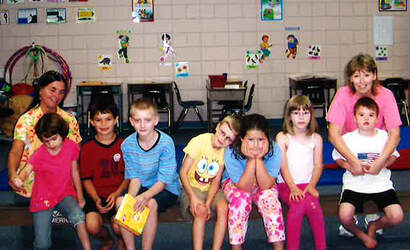 Linda (right), pictured with a Summer Boost Up class from 2006. Linda (right), pictured with a Summer Boost Up class from 2006. Today, Matthew is grown up, steadily employed at a local store for the last seven years, and the father of four-year-old Xander. “If it wasn’t for my experience with New Visions, with A Chance to Grow, I would not have been able to recognize early that Xander had challenges. “First thing is the speech, he wasn’t saying words and he’s not playing like a neurotypical toddler.” He was diagnosed with Autism, low on the spectrum and sensory seeking. She told Xander’s mom that she should bring him to ACTG for an occupational therapy evaluation. Today, Xander is receiving speech and occupational therapy at A Chance to Grow. While Matthew left New Visions for middle school, and has since gone on to lead a wonderful life, Linda remained at ACTG. It was her second career, after spending 25+ years in the telephone answering service, but, she says, “Boost-Up became my first love.” Over the years, her involvement has grown and changed, just as the agency has. Eventually, she also worked for the AVE program, Vision program, and as it expanded, the Clinical Services department as a clinical assistant. She has never formally retired because, as she says, this has become a family affair too. “The people here, they mesh so well together. I think it’s because the love and dedication they have in helping children be successful is a common goal. She says, because of that shared goal, “the staff is like family, too.” NOTE: Growing with the times, A Chance To Grow now offers insurance-based OT, Speech, Vision, and Audiology services, as well as private-pay Neuro Integrative, Neurofeedback and AVE services.
“As a kid, I had a harder time reading,” says Leah, a veteran educator currently with the Eau Claire, WI school district and a long-time S.M.A.R.T. advocate, whose passion for teaching and love for her students are palpable. “And I want to do everything in my power to prevent others from struggling.”
After several years in the classroom, Leah found herself in a position to support other teachers – as an educational consultant, instructional coach, literacy coach, Title I teacher, among other roles. While teachers were telling her that student behavior was their biggest problem, as a literacy coach and Title I teacher, she noticed that many children were having reading issues. “I had several kids, I could actually see their eyes doing different things on the pages, or they’d look at me and their eye would bounce, and I thought ‘something is going on there.’” Then she attended a training for a movement-based program that dealt with dyslexia. Her original teacher training had included very little about brain-related issues or the importance of movement to development. This new perspective changed her. “I started telling parents, ‘you might want to get their eyes checked, I’ve been noticing some things’ and parents wrote to me to say, ‘There was an issue, thanks for telling us!’ I thought, this is knowledge that everybody needs to have. It’s great and more students could be helped.” Several years later, when she attended a three-day S.M.A.R.T. training, it was revelatory: “Every time I heard a story I thought ‘oh, that was that kid.’ I remember having an a-ha moment: They showed us how the alligator crawl is really good for reading comprehension, and I thought, ‘why have I not been doing this the whole time with the struggling readers?’”
Movement Anchors Learning! Movement influences the ability to concentrate in a classroom and to learn to read and write. The body is designed to move. Research shows purposeful, specific, and systematic physical movement can affect the brain in a very positive and dramatic way. Physical activity helps create an optimal learning condition for the brain by:
Leah began to advocate for all teachers in the district to incorporate S.M.A.R.T. into their classrooms. Last year, district administrators went all in, arranging for all teachers and assistants to get trained. “The first time through the training, some of [the teachers] said, ‘oh my gosh, I thought this kid was doing this because they were misbehaving but really, they had this sensory or auditory processing or vision issue.’ They started to see behaviors differently, which I think is amazing.” Her S.M.A.R.T. training continues to inform her practice. When her colleagues say, “This child has ADHD” she asks, “’Have you tried spinning? Or balancing? Or pencil rolls? Let’s start with some of those.’ I say to parents, do you ever notice them spinning? And they say ‘yeah.’ And I say, ‘let them, they need it, their bodies are telling them they still need to move.’”
“I have probably three or four kids with high behavioral needs. One of my little guys used to have really large emotions and now you wouldn’t really recognize him. Does he still have moments? Absolutely, we still have to work on it. However, he’s really calmed down quite a bit. His mom said, ‘oh my gosh, he has improved by leaps and bounds.’”
“We are a container society, we are putting our kids in car seats to highchairs to bouncy seats and they are never getting those experiences on the ground, and those experiences are the ones that lead to academic success. We should tell parents ‘Don’t rush them, there are a lot of stages we try to rush through, and quite honestly they need to be on the ground moving.’"
For parents of older children that are having problems academically or behaviorally, Leah says, “There’s a lot of brain-based activities that we can be doing, even at upper levels. My favorite video to show people is The Brain Highway, because there’s always someone who says ‘oh, yeah, I get it!’ when they see it.” Boost-Up Plus is a 3-week multisensory summer camp for children ages 5-11 that focuses on stimulating physical and cognitive development through fun and challenging gross motor, fine motor, vision and auditory activities. Incorporating elements of A Chance To Grow’s S.M.A.R.T. approach, the program is able to influence a child’s ability to learn, think and remember, ultimately giving them the confidence they need to achieve success in and out of the classroom. “It’s a holistic approach to help children reach their full potential,” says Patrick Dreher, a Developmental Adaptive Physical Education Teacher in the Robbinsdale district and instructor of the Boost-Up Plus program. “We work on building automatic responses in the brain, like balance, hand-eye coordination and cross-lateral skills through our ever-changing course of activities. As these abilities become more automatic, students are more likely to absorb and retain the information being taught in the classroom, because they are more prepared to learn.”
Patrick returned to school and earned several degrees, including a Master of Science in Special Education. He would later attend a conference for physical educators where he was first introduced to A Chance To Grow’s S.M.A.R.T. approach. This experience reinforced his belief that a moving child is a learning child. As fate would have it, he was hired shortly after as a physical education teacher at the Minnesota Transitions School, which happens to be in the same building as A Chance To Grow. Patrick attended a 3-day S.M.A.R.T. workshop at ACTG and began introducing elements he learned into his own curriculum. The administration supported his efforts, and soon he was helping his students get the recommended 30 minutes of S.M.A.R.T. activities each day. Upon seeing this, the coordinators of Boost-Up Plus invited Patrick to join the team for the upcoming summer program, an invitation he happily accepted. Since 2015, Patrick has been a Boost-Up Plus instructor and relishes the opportunity to lead the program each summer. “It’s difficult in a school environment because I sometimes only see students twice a week, which isn’t enough time to reach the 80 hours a year we aim for. It can take 2-3 school years to see any improvements at that rate. But in the summer, we have three weeks to work on specific things for each child and you can see progress happen much faster.” “Every child has their own starting point and progress means different things for different people,” says Patrick. “We begin with an initial assessment to see where the child is and identify what skills we want to work on over the course of the camp. We make individualized adaptations as much as possible, and the obstacle course changes from day to day.” The course includes activities like belly crawling, balance beams, overhead ladders, fine motor work stations and more. “We meet the students at their level by making the course incrementally harder or easier, depending on their individual needs. They appreciate the changes and that excitement fuels their motivation to reach their potential for that day.” “There’s lots of different things I’ve seen and done that have worked great for some students, but not for others,” says Patrick. “This program works for everyone.”
Patrick relishes the moments when it “clicks” for the students, when they realize that they have the capacity inside of themselves to overcome obstacles on their own. “Once they know they have that power, they can do anything,” says Patrick. “It’s rewarding when they want to challenge themselves to be better or faster on the course. They begin to see that if they put in the work, they are going to make progress and find success. Confidence breeds success, and success breeds more success.” Tell us about your child’s situation and discover how we can help. Children of all capabilities are welcome to attend Boost-Up Plus. Please submit an inquiry form to get started. I first heard about A Chance to Grow and the Summer Boostup program from a pediatric physical therapist I know. I had told her my concerns about my daughter's memory and coordination even though she had no formal diagnosis. She was always a super bright kid (reading at age 2) but started having trouble remembering facts in school including math facts and had difficulties with reading comprehension.
I also told my sister about the Boostup program as she had a daughter struggling to learn to read and had a speech language pathologist tell her she was dyslexic. The pediatric physical therapist told me if I just took my daughter to any regular physical therapist or occupational therapist they would struggle with goals for her since she was so high functioning, but A Chance to Grow would find things to work on to help her. I decided to take my RV to Minneapolis for the three weeks of Boostup for two of my three children and my sister joined me with her two children. While there, we also had a couple of reflex integration sessions. We both noticed positive changes in our children after about a week. My daughter became more adventurous on the playground and my niece, age 10, read her first book! We were very happy with how much we learned about the brain while we were there. A Chance to Grow exceeded our expectations. Even before we went, I felt that the program was worth the price and it definitely was. We are hoping to return to A Chance to Grow next summer for more Boostup and reflex integration. Carol, Wisconsin “Dear Dr. Moroz and Staff of A Chance to Grow,
Our son had a miserable first grade experience. His teacher strongly suggested he had ADHD. She also refused to allow me to visit her classroom to see why he was struggling with his work tasks. Ben was tagged as an SLD student and I was told I should just accept that he would always have trouble learning. On Valentine’s Day, there was a party and I arrived early to pick him up. Within minutes of watching him, I could tell he was having trouble copying words from the board. That started the rail of discovery that led us to you. An article in the newspaper was brought to our attention and we decided to give you a call. What a blessing that call turned out to be! With the expertise of Dr. Moroz we were able to determine that Ben had six different visual delays. She also suggested that we have a specialist check his hearing. That advice led to the discovery that Ben also had auditory processing delays. We enrolled our son in your summer Boost Up Program. In that short period of time, Ben’s vision improved remarkably. For the first time in his life, he saw visual details that we didn’t even know he was missing out on. Things like the small minute lines between the numbers on a clock, street signs and numerous wildlife creatures now appeared in his visual world. Although no one we asked knew about your school, we decided to trust your school and enrolled Ben for the upcoming year. It was a decision we will never regret. Ben entered second grade reading at below a first grade level. At the end of the year, he loved to read and was reading at a 4.2 grade level. Wow! Recently, we received the results from the Minnesota Department of Education Comprehensive Assessment Series II. I thought you might be interested in the results of how Ben ranks in the state when compared to his peers. In both the Reading and Math portions of the assessment, Ben received scores that placed him in their highest ranking of 'Exceeds the Standard.' A closer look at his reading scores shows a comprehension section that placed him in the 99th percentile in the state. His success can be directly related to your efforts and we thank you from the bottom of our hearts. May God bless you all for the outstanding service and opportunities you have given Ben and other children with visual and hearing difficulties.” --Dave and Judy Schink Most days during the 2017 school year, Jamie Bartels’ classroom at South Central Calhoun Elementary was full of young students neatly packed into a 24-station computer lab. They would come in, put on a pair of headphones and quietly click away as they steadily stared into a glowing screen. “I was concerned by my student’s lack of engagement,” said Mrs. Bartels. “I felt it was time to make a change at our school. We needed to get our kids moving!” In an effort to shift this trend, she inquired with her school’s instructional coach (staff member that helps bring evidence-based practices into classrooms) to seek out an alternative program for her students. The coach recommended S.M.A.R.T. (Stimulating Maturity through Accelerated Readiness Training) -- a developmental approach to teaching built around a variety of physical exercises that provide specific brain stimulation associated with learning. These activities, designed to be done daily in a single 30-minute period, strengthen a child’s visual and auditory skills, body awareness, fine motor abilities and primitive reflexes. Since 1999, more than 5,000 educators in 300 schools across the country have implemented the program to prepare their student’s readiness to learn. It was the exactly what Mrs. Bartels was looking for. When the school year ended, Jamie traveled from Rockwell City, Iowa, to Minneapolis to attend a three-day S.M.A.R.T. workshop at A Chance To Grow. The summer-time workshop provided Jamie with lots of ideas to get her students moving, and the notion of transforming her computer lab into a S.M.A.R.T. room began to percolate. “I didn’t realize the impact these simple activities could make in a student’s overall ability to learn,” she said. “I couldn’t wait to get back to school to share with the other teachers what I learned and to begin implementing S.M.A.R.T. activities in my room.” Mrs. Bartels returned to her classroom in September and immediately began clearing out computers to make room for the new S.M.A.R.T. stations. With support from school administrators, she was able to create a 12-activity circuit in her S.M.A.R.T. room (formerly known as the computer lab), comprising of a hanging ladder, two rebounders, fine and gross motor activities, word ladders and more. “The kids really like it”, she said, “they’re excited to come to class.” Mrs. Bartels is now the school’s official S.M.A.R.T. Teacher. In its inaugural year, she says, pre-K through third grade classes spend 30 minutes in the S.M.A.R.T. room, twice weekly, as part of the curriculum. In her brief time working the program, she has already seen several positive changes in student performance. “I had a second grade student who wasn’t interested in trying anything new,” said Mrs. Bartels. “After a few weeks in the S.M.A.R.T. room, his attitude completely changed. I’ve been able to connect with him and he’s a whole new kid when he comes to school. He doesn’t need any convincing to do the activities and his other teachers say he’s more engaged in their classes too.”
Jamie has also seen changes in a few students with behavioral issues. She loves that students are able to come in and do a few stations to burn off some restless energy. She says the program allows her to work one-on-one with these students to build a level of trust that helps in all aspects of the school day. “All the teacher’s love it and our class aids are starting to learn some of the techniques as well,” she said. “Parents are very curious, too. We sent a letter home explaining the program and invited them to tour the room during parent-teacher conferences. It was so fun to see the students walk their parents through the S.M.A.R.T. room to explain the stations and the reasons behind the activities.” Mrs. Bartels’ third-graders recently completed a survey and voted S.M.A.R.T. as their favorite “special” class during the week. Jamie hopes to expand the program going forward, but admits the biggest obstacle is finding enough time throughout the week to make sure each student gets adequate S.M.A.R.T. time. To address this, she plans S.M.A.R.T. activities during recess. “I really enjoy finding new ways to implement activities and adapt stations that become repetitive,” she said. “The difference between last year and this year is amazing. We have a whole lot more fun learning now, and we want to keep it that way!”
I like to call it a brain-based therapeutic summer camp! Kids and adolescents would participate in a three-week daily program that included cutting-edge brain-based treatments and therapies. The best part was that everything was rolled up into a fun social experience so the kids were having a blast and happy, even though they were working hard five days a week.
We made tremendous progress each summer and reentered the next school year “notched up”; not only physically, but also in reading comprehension and processing speed. The bonus was that we also met other amazing families who we are still friends with today! From Boost Up Plus we transitioned into ongoing beneficial brain-based therapies such as Neurofeedback, Neurological Reorganization, vision therapy, and auditory integration therapy. As my son is becoming a young adult, the services and staff have grown with him; from improving speech deficits, processing disorders, and delayed motor skills early on to decreasing severe anxiety and sensory sensitivities as a teenager. At ACTG, we always find a solution. I would also like to mention how special the leadership team and professionals are at ACTG. Many of them have been here for years, which says a lot. They are passionate about their work and really care about our kids and families. They also are eager to learn and expand services as research surfaces. This is critical with complex disorders that involve the brain and neurological systems. So I guess it’s not a surprise to say that I enthusiastically joined the board several years ago and will be honored to continue serving as we move forward with our journey as a family and organization. A chance to grow; it describes our experience perfectly. I’m excited about the future; with my family, my special child and this amazing unique organization. - Julie, mother Justin the Superstar! Before visiting A Chance To Grow, Justin would hesitate in the middle of words when trying to speak, which made it hard for anyone else to understand him. In first grade, he didn’t know all of his sounds and reading and writing frustrated him.
In October of his first grade year, Justin was falling behind and began to hate school. He felt he was stupid. It brought tears to his mother’s eyes. In November of that year, she attended the S.M.A.R.T. Workshop and met Cheryl Smythe, Assistant Director of the Minnesota Learning Resource Center (MLRC). Cheryl encouraged her to have his vision and auditory processing skills tested at A Chance To Grow. The testing told her he was below age level in much of his developmental vision, so she started doing boost up (S.M.A.R.T.) activities at home with him. He worked really hard on Creeping, Crawling, Spinning and Rolling, enabling him to move onto vision therapy activities. His mother also started him on the Hemispheric Specific Auditory Stimulation (HSAS) (now JIAS) program at A Chance To Grow to help with his auditory processing. Within three weeks of starting HSAS, Justin was able to sing all the words at his Christmas program on beat and with the other children-- something he hadn’t been able to do before. WOW! First grade was a struggle, but Justin had made it through. When second grade started, the school tested him at a pre-primer reading level. Him and his mother continued to work on his vision and auditory issues. He showed real strength in math and by the end of second grade he was at a 1.7 reading level. This was almost an improvement of two grades! By the end of his second grade school year, Justin was done with vision therapy and was put onto maintenance for the HSAS program. By this point, Justin’s articulation had improved so much that many people didn’t know he even had an articulation delay. In third grade, he was still struggling with writing and still behind in reading. He received Title 1 services and worked hard at home. Justin did score ‘proficient’ on the Wisconsin state reading test that March, but things still didn’t seem quite right. He was having a hard time following along and keeping up in the classroom. A Chance To Grow checked his ears again and found he had regressed on his auditory processing skills. After also having his reflexes checked by Dr. Moroz at A Chance To Grow Vision Services, it was found that he still had some primitive reflexes interfering with his ability to write and maintain the progress he had made in some of his prior therapy. Within weeks of starting the reflex therapy at home, he commented on how much “easier” writing was. Then, when given the choice to read, write or do math (his favorite), he chose writing. He wrote three stories that summer. This was great for a child who at one time had a hard time writing one word! Justin, you are a superstar! |
success story category:
All
WE LOVE HEARING FROM YOU! |


